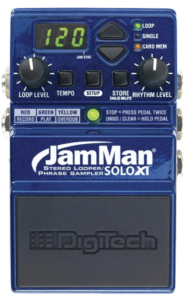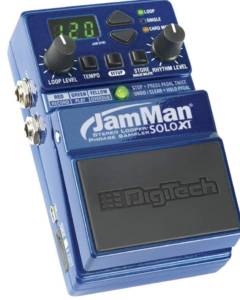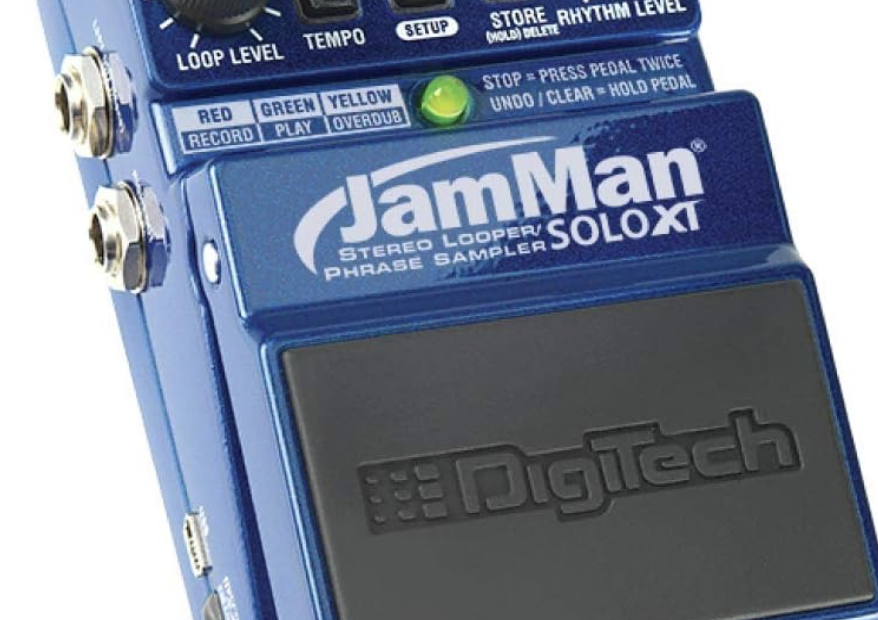The DigiTech JamMan Looper Pedal is a versatile looping pedal designed for guitarists and musicians. It allows users to create, store, and manipulate loops of audio, making it a valuable tool for live performances, practice sessions, and creative music production.
Features
 Here are some key features and information about the DigiTech JamMan Looper Pedal [link].
Here are some key features and information about the DigiTech JamMan Looper Pedal [link].
The JamMan pedal [link] enables you to record and play back loops of audio in real-time. You can layer multiple loops on top of each other, creating complex arrangements and backing tracks.
The recording time available on the JamMan may vary depending on the specific model or version. Some versions offer longer recording times than others. Some models even provide the ability to expand memory using an SD card.
Using the looping capabilities of the DigiTech JamMan Looper Pedal involves several steps, allowing you to create, manipulate, and play back loops. Below are the basic instructions on how to use the looping features of the pedal:
Setup:
- Connect Your Guitar: Plug your guitar or instrument into the input jack of the JamMan pedal.
- Connect to Amplifier or Mixer: Connect the pedal’s output(s) to your amplifier or mixer. Make sure you have a way to hear the looped sound.
- Power: Ensure the pedal is powered with a suitable 9-volt DC power supply.
Also Read:
Electro-Harmonix 720 Stereo Looper
MXR Clone Looper Guitar Effects Pedal: Review
BOSS RC-505MKII Loop Station Pedal Review
MOOER Groove Loop Drum Machine Review
TC Electronic DITTO+ Looper Review
BOOMERANG III Phrase Sampler: Guitar Effects Looper Review
7 Best looper pedals for guitar
Creating a Basic Loop
- Record a Loop:
- To record a loop, tap the footswitch labeled “REC/PLAY/STOP” once. The pedal will enter record mode, and the LED indicator may flash or change color to indicate that you’re in recording mode.
- Play your musical part (e.g., a chord progression, riff, or melody). The pedal will capture this and begin looping it. The LED indicator may change to indicate that the loop is recording.
- Overdub:
- While the loop is playing, you can add overdubs (additional layers) to it. Tap the “REC/PLAY/STOP” footswitch again when you want to start overdubbing. The LED indicator may change to indicate overdub mode.
- Play any additional parts or melodies you want to layer onto the loop. These overdubs will be added to the existing loop.
- Stop Playback:
- To stop playback, tap the “REC/PLAY/STOP” footswitch a third time. The LED indicator may change to indicate that the loop is not playing.
- Undo/Redo:
- If you make a mistake or want to undo your last overdub, some models of the JamMan pedal allow you to hold down the “REC/PLAY/STOP” footswitch for a few seconds to undo the last overdub. You may be able to redo it by tapping the footswitch again.
 Performing Loop Management
Performing Loop Management
- Select Stored Loops:
- The JamMan pedal can store multiple loops. Use the footswitches or controls provided on your specific model to select and switch between stored loops.
- Clear a Loop:
- To clear the currently selected loop, refer to the pedal’s manual for instructions specific to your model. Some pedals require a specific button combination or a press-and-hold action to clear a loop.
Using the Metronome
- Activate Metronome:
- If your JamMan pedal features a built-in metronome, consult the manual for instructions on how to activate it. This can help you stay in time while recording and overdubbing loops.
- Adjust Metronome Tempo:
- Use the controls provided on your specific pedal to adjust the tempo of the metronome, if applicable.
Loop Storage
The JamMan [link] typically allows you to store and access multiple loops. This means you can create loops for different songs or musical sections and switch between them during live performances.
DigiTech designed the JamMan to be user-friendly, with intuitive controls for recording, overdubbing, playing, and stopping loops. It often includes LED indicators to provide visual feedback on loop status.
Many looping pedals, including the JamMan, include an undo/redo function. This allows you to quickly erase the last layer you recorded if you made a mistake and then redo it if needed.
Built-in Metronome and Drum Patterns:
 Some versions of the JamMan pedal [link] feature a built-in metronome with various rhythm patterns. This is useful for staying in time while recording and overdubbing loops.
Some versions of the JamMan pedal [link] feature a built-in metronome with various rhythm patterns. This is useful for staying in time while recording and overdubbing loops.
To use the built-in metronome and drum patterns on the DigiTech JamMan Looper Pedal, follow these general steps:
1. Accessing the Metronome and Drum Patterns:
- Most JamMan models with a metronome and drum patterns feature a dedicated button or switch for accessing these functions. Consult your pedal’s manual to locate this control, as its location and labeling may vary between models.
2. Activating the Metronome:
- Press the button or switch associated with the metronome function. The LED indicator or display on your pedal should indicate that the metronome is active.
3. Setting the Tempo:
- Once the metronome is activated, use the tempo control or tap tempo function (if available) to set your desired tempo. The LED display or metronome indicator should reflect the tempo you’ve selected.
4. Selecting Drum Patterns:
- If your pedal includes drum patterns, use the dedicated drum pattern selection control or button to cycle through the available patterns. Most models offer various rhythms like rock, blues, funk, and more.
5. Adjusting Drum Pattern Volume:
- Some models allow you to adjust the volume of the drum patterns separately from the looped audio. Refer to your pedal’s manual for instructions on how to adjust the drum pattern volume if needed.
Using the Metronome and Drum Patterns during Looping
While creating and recording loops, the metronome provides a consistent tempo reference to help you stay in time. You can record your loops while listening to the metronome, which can be particularly useful for precise timing.
If you wish to include a drum pattern in your loop, select the desired pattern before recording your loop. The drum pattern will play alongside your recorded audio.
To turn off the metronome or drum patterns, press the metronome/drum button or switch again. The LED indicator should indicate that the metronome and drum patterns are inactive.
Using the Metronome and Drum Patterns for Practice
The metronome and drum patterns are valuable tools for practice. You can use them to practice scales, solos, and rhythm patterns in time with a consistent beat.
The JamMan pedal is often compatible with external footswitches, which can be used to control functions like loop selection, clear all loops, or toggle the built-in metronome.
Import/Export Loops:
Some models of the JamMan allow you to import and export loops via USB or other connectivity options. This can be useful for backing up your loops or integrating them into digital audio workstations (DAWs).
Some versions of the JamMan pedal feature true bypass switching, ensuring that your guitar’s original tone remains unaffected when the pedal is not in use.
Power Requirements
The pedal typically operates on a standard 9-volt DC power supply. Ensure that you have a suitable power source available.
The DigiTech JamMan Looper Pedal is a versatile and powerful tool for guitarists and musicians looking to incorporate looping into their music. Its features and capabilities make it suitable for a wide range of applications, from solo performances to collaborative jam sessions.
